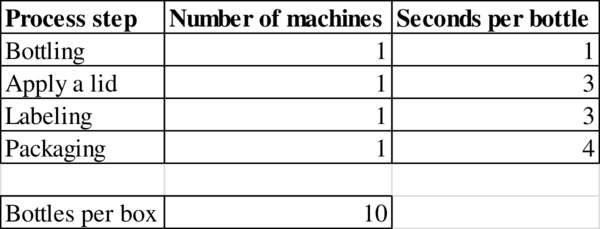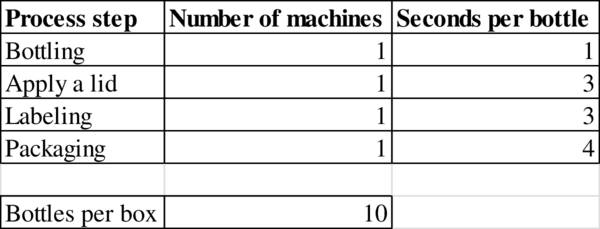
Concept explainers
a)
To draw: A process flow diagram for this process.
a)
Explanation of Solution
Given information:

Process flow diagram:

b)
To determine: The capacity at the resource “Apply a lid”.
b)
Explanation of Solution
Given information:

Calculation of capacity:
The capacity is 1,200 bottles.
c)
To determine: The bottleneck in the process.
c)
Explanation of Solution
Given information:

Determination of bottleneck:
The process step with the longest processing time “seconds per bottle” is the bottleneck in the process. Packaging has the highest time of 3 seconds per bottle.
Hence, the bottleneck is Packaging.
d)
To determine: The flow rate.
d)
Explanation of Solution
Given information:

Determination of flow rate:
The flow rate is 900 bottles.
e)
To determine: The utilization of resource “Apply a lid”
e)
Explanation of Solution
Given information:

Calculation of utilization:
The utilization is 75%.
f)
To determine: The utilization of bottling.
f)
Explanation of Solution
Given information:

Calculation of utilization:
The utilization is 20%.
g)
To determine: The cycle time of the process.
g)
Explanation of Solution
Given information:

Calculation of cycle time:
The demand is constrained and has a flow rate of
The cycle time is 5 seconds.
h)
To determine: The time taken to produce 500 bottles.
h)
Explanation of Solution
Given information:

Calculation of time taken to produce 500 bottles:
The time taken to produce 500 bottles is 2,515 seconds.
Want to see more full solutions like this?
Chapter 3 Solutions
Operations Management With Connect
- A process of making chair is described as follows: Stage 1 Seat and back attached Stage 2 Legs attached The production speeds are 15 chairs per hour for Stage 1 and 30 chairs per hour for stage 2. The cycle time of the process is ______minutes. The flow time of the process is ______ minutes.arrow_forwardThis is a step in a process that is the slowest compared tothe other steps. This step limits the capacity of the process.arrow_forwardHammond Inc. has analyzed the setup time on its computer-controlled lathe. The setup requires changing the type of fixture that holds a part. The average setup time has been 135 minutes, consisting of the following steps: Step Time (in minutes) Turn off machine and remove fixture from lathe 13 Go to tool room with fixture 15 Record replacement of fixture to tool room 18 Return to lathe 20 Clean lathe 17 Return to tool room 20 Record withdrawal of new fixture from tool room 12 Return to lathe 15 Install new fixture and turn on machine 8 Total setup time 138 Why should management be concerned about improving setup time? What do you recommend to Hammond Inc. for improving setup time? How much time would be required for a setup, using your suggestion in (b)?arrow_forward
- The Flip Chip Company manufactures nacho chips, potato chips, and related products. There has been a problem in the manufacture of nacho chips. The process begins with the mixing of water, corn and lime (called the MASA). A mixer can produce a batch of 300 lbs of MASA in 2 minutes. The MASA is then cooked. This takes 30 minutes. Only 95% of the MASA makes it to the ovens and of that only 75% is transferred to the next step. There are four ovens. The next step is chip making. The MASA is extruded into the chip itself and the chips are baked. There are 2 chip machines. A total of 950 chips/minute are produced (each chip weighs approximately .5oz). The yield from this process is 72%. The chips are then placed in 20 oz bags. This step takes 2 seconds for each bag. Where is the bottleneck? What recommendation would you make?arrow_forward. Consider the following four-step assembly operation with quality problems. Allresources are staffed by one employee.• The first resource has a processing time of 5 minutes per unit.• The second resource has a processing time of 6 minutes per unit.• The third resource has a processing time of 3 minutes per unit. With a 30 percent probability, the flow unit coming out of the third resource has to be reworked. In that case,the operations at the first, second, and third resources are repeated. You can assumethat (a) rework always succeeds (i.e., a unit going through the rework loop will alwayswork after the third resource) and (b) the processing times for units in rework are thesame as for regular units.• The fourth resource has a processing time of 4 minutes per unit.a. Where in the process is the bottleneck?b. What is the capacity of the process?arrow_forwardConsider the following four-step assembly operation with quality problems: The first resource has a processing time of 5 minutes per unit and one employee doing the operation. The second resource has a processing time of 4 minutes per unit. It also has one employee doing the operation. However, this is a very delicate task and 80% of all products have to be scrapped after this step. Two workers are staffed for the third resource. No quality problems occur at this resource and the processing time is 20 minutes per unit. At the fourth and final resource, one operator handles the product. No quality problems exist at this step and the processing time is 12 minutes per unit. For every unit of demand, how many units have to flow through the second step in the process?arrow_forward
- Consider the following four-step assembly operation with quality problems: The first resource has a processing time of 5 minutes per unit and one employee doing the operation. The second resource has a processing time of 4 minutes per unit. It also has one employee doing the operation. However, this is a very delicate task and 80% of all products have to be scrapped after this step. Two workers are staffed for the third resource. No quality problems occur at this resource and the processing time is 20 minutes per unit. At the fourth and final resource, one operator handles the product. No quality problems exist at this step and the processing time is 12 minutes per unit. Where in the process is the bottleneck?arrow_forwardJCL Inc. is a major chip manufacturing firm that sells its products to computer manufacturers like Dell, Gateway, and others. In simplified terms, chip making at JCL Inc. involves three basic operations: depositing, patterning, and etching. Depositing: Using chemical vapor deposition (CVD) technology, an insulating material is deposited on the wafer surface, forming a thin layer of solid material on the chip. Patterning: Photolithography projects a microscopic circuit pattern on the wafer surface, which has a light-sensitive chemical like the emulsion on photographic film. It is repeated many times as each layer of the chip is built. Etching: Etching removes selected material from the chip surface to create the device structures. The table below lists the required processing times and setup times at each of the steps. There is unlimited space for buffer inventory between these steps. Assume that the unit of production is a wafer, from which individual chips are cut at a later…arrow_forwardA customer wants 38,400 parts for the next month and the production line operates continuously for 16 hours per day. It is known that the company works 20 days per month. Determine the Takt Time in parts per second.arrow_forward
- Consider the following three-step assembly operation with quality problems. All resources are staffed by one employee. The first resource has a processing time of 7 minutes per unit. The second resource has a processing time of 6 minutes per unit. The third resource has a processing time of 5 minutes per unit. With a 40% probability, the flow unit coming out of the third resource has to be reworked. In that case, the operations at the second and third resources are repeated. You can assume that (a) rework always succeeds (i.e. a unit going through the rework loop will always work after the third resource),and (b) the processing times for units in rework are the same as for regular units. Where in the process is the bottleneck? 1 point Step 3 Step 2 Step 1 5.Question 5arrow_forwardConsider the following three-step assembly operation with quality problems. All resources are staffed by one employee. The first resource has a processing time of 7 minutes per unit. The second resource has a processing time of 6 minutes per unit. The third resource has a processing time of 5 minutes per unit. With a 40% probability, the flow unit coming out of the third resource has to be reworked. In that case, the operations at the second and third resources are repeated. You can assume that (a) rework always succeeds (i.e. a unit going through the rework loop will always work after the third resource),and (b) the processing times for units in rework are the same as for regular units. For every unit of demand, how many units have to flow through the second step in the process?arrow_forward. Consider the following three-step assembly operation with quality problems. Allresources are staffed by one employee.• The first resource has a processing time of 7 minutes per unit.• The second resource has a processing time of 6 minutes per unit.• The third resource has a processing time of 5 minutes per unit. With a 40 percentprobability, the flow unit coming out of the third resource has to be reworked. In thatcase, the operations at the second and third resources are repeated. You can assumethat (a) rework always succeeds (i.e., a unit going through the rework loop willalways work after the third resource) and (b) the processing times for units in reworkare the same as for regular units.Where in the process is the bottleneck? What is the capacity of the process?arrow_forward
 Practical Management ScienceOperations ManagementISBN:9781337406659Author:WINSTON, Wayne L.Publisher:Cengage,
Practical Management ScienceOperations ManagementISBN:9781337406659Author:WINSTON, Wayne L.Publisher:Cengage, Operations ManagementOperations ManagementISBN:9781259667473Author:William J StevensonPublisher:McGraw-Hill Education
Operations ManagementOperations ManagementISBN:9781259667473Author:William J StevensonPublisher:McGraw-Hill Education Operations and Supply Chain Management (Mcgraw-hi...Operations ManagementISBN:9781259666100Author:F. Robert Jacobs, Richard B ChasePublisher:McGraw-Hill Education
Operations and Supply Chain Management (Mcgraw-hi...Operations ManagementISBN:9781259666100Author:F. Robert Jacobs, Richard B ChasePublisher:McGraw-Hill Education
 Purchasing and Supply Chain ManagementOperations ManagementISBN:9781285869681Author:Robert M. Monczka, Robert B. Handfield, Larry C. Giunipero, James L. PattersonPublisher:Cengage Learning
Purchasing and Supply Chain ManagementOperations ManagementISBN:9781285869681Author:Robert M. Monczka, Robert B. Handfield, Larry C. Giunipero, James L. PattersonPublisher:Cengage Learning Production and Operations Analysis, Seventh Editi...Operations ManagementISBN:9781478623069Author:Steven Nahmias, Tava Lennon OlsenPublisher:Waveland Press, Inc.
Production and Operations Analysis, Seventh Editi...Operations ManagementISBN:9781478623069Author:Steven Nahmias, Tava Lennon OlsenPublisher:Waveland Press, Inc.





